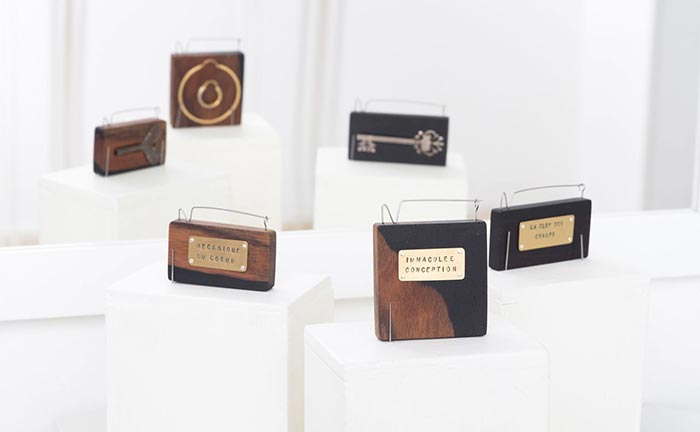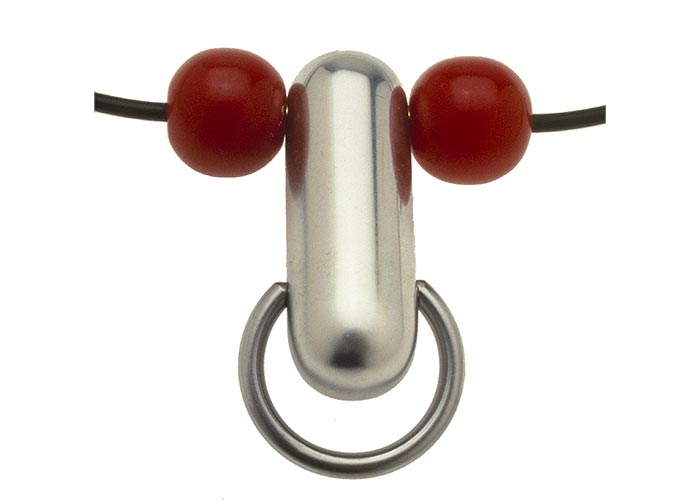Business
14 July 2017
Share
Avant-garde jewelry in the “Medusa” exhibition
A large part of the exhibition is dedicated to this type of jewelry, also known as “contemporary” jewelry and still relatively unknown in France.
“Contemporary jewelry” draws on sociology and psychoanalysis, exploring the issues of value and genre – two of the themes explored by “Medusa’” It often consists of a single item created with unconventional materials, overturning conventions and shattering the myth of diamonds and gold. This complex and intricate form of jewelry often borrows from contemporary art and a great deal has been written about it. It is sold in galleries and as portability is not its primary aim, it often ends up in some of the most prestigious museums in the world, such as the MUDAC in Lausanne, the Schmuckmuseum in Pforzheim or the Van den Bosch Foundation. Here are some jewelry pieces blurring the boundary between fashion, design and art.
Transforming “everyday” materials
– Verena Sieber has used butcher paper for her “Wedding” necklace. On the face of it, this piece appears so charming and feminine, but Sieber superimposes a bride’s fleeting beauty with the brutality of an animal’s death.
– Bernhard Schobinger’s favorite materials are usually those destined for the bin. Bottle necks threaded together to form a necklace provide food for thought about the consumer society and the waste that it produces, leaving us torn between the desire to wear it and fear of the pain caused by the sharp edges.
– This is not corrugated cardboard stapled together, but it is impossible to avoid this extraordinary illusion that represents this Swiss creator’s obsession and flair when it comes to textures, colors, trompe-l’œil and pretense. David Bielander’s strikingly hyperrealistic bracelet is actually made of yellow and white gold.
Demonstrating absence
– With her “Epitaph” brooches, Laurence Verdier revives jewelry that women no longer wear, those items that lie forgotten in the drawer. She sets them in wood like precious stones and gives them a label; this small earring inside a larger one is accompanied by the enigmatic words “Immaculate Conception”.
– Galatée Pestre explores this very theme by sublimating jewelry that has been lost in the street or on a train. She makes a silicone impression of the item, then “sketches” it in gold thread to reveal its soul. The original piece also becomes a part of this highly lyrical collection.
Condemning the diktats of appearance
“Inner Beauty” is dematerialized jewelry, a drinkable solution displayed in a bottle together with a small spoon. Frédéric Braham’s homeopathic mixture of gold, silver and copper points the finger at norms and social representations of the body in a society ruled by appearance. He also uses meaningful items such as this brooch created from a real Yves Saint Laurent powder compact; the make-up inside it creates a camouflage motif.
Performance by Frédéric Braham at the Musée d’Art Moderne on 12 October 2017.
Daring to get intimate
“Getting old sucks” consists of two black valve pins to be placed on the breasts. “They represent the decadence of the female body and its consequences for romantic relationships”, explains designer Benjamin Lignel, who placed the pins on his mother in a highly controversial photo. There is very little chance of seeing these breast brooches on the street, but they are now showcased in museums.
Flaunting the penis
– This aluminum necklace was designed for a men’s fashion show by Paul Derrez, owner of the Ra gallery in Amsterdam. “Contrary to what I thought, it was more popular with women than with the gay community. That’s logical – why would you wear a pierced phallus if you’ve already got one?”
– Swiss designer Sophie Hanagarth is regarded as the embodiment of avant-garde jewelry, famous for combining very specific metalwork with her thoughts on the relationship with the body, sensuality and sexuality. One of her symbolic items is the “Family jewels” necklace, a flexible item that sits close to the body, reaching down to the groin and drawing attention to the invisible parts that we hide, in this case two testicles made from beer bottle caps.
Front picture: Galatée Pestre, found jewelry collection © Matthieu Gauchet
Banner picture: Benjamin Lignel’s jewelry in the “Medusa” exhibition © Pierre Antoine


















